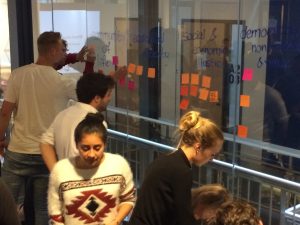Students differ in terms of interests, prior knowledge and skills, and learning preferences to a great extent. As a consequence, students have different levels of motivation, attitudes about teaching, and responses to specific instructional practices. How can you address these differences in your teaching?
Students in higher education differ in (Felder & Brent, 2005):
- Learning preferences
Some students are comfortable with theories and abstractions; others feel much more at home with facts and observable phenomena; some prefer collaborative learning and others value individual learning; some prefer verbal explanations and others prefer visual representations.
- Approaches to learning and orientations to studying
Students tend to approach their courses in three ways:
- Students who have an orientation to reproduction tend to adopt a superficial approach, relying on memorisation and making little or no effort to understand the material being taught.
- Students who have an orientation towards meaning tend to adopt a deep approach; probing questions and exploring the (conceptual) limits.
- Students who have an orientation towards achievement might adopt both a surface or deep approach, doing whatever is necessary to get the highest grade they can.
Getting started
Firstly, try to get to know your students. A straightforward way is being aware of verbal and non-verbal feedback from your students. Students might complain about the level of the course content, express demotivation, show procrastination or work in a superficial manner. This may indicate that students either need more instruction or need to be guided towards an orientation that promotes meaning. Another approach would be to discuss the differences and resulting preferences. Some students may feel uncomfortable expressing their needs and aims. Online tools give students the opportunity to be more honest in their responses as they can stay anonymous to their peers.
Secondly, adapt to students’ need in terms of the content, the learning activities, the level and/or educational tools or challenge students to go the extra mile. Some example are:
- Learning activities: Taking differences in learning preferences into account, alternate between individual and group work, concrete and conceptual exercises and written or visual explanations. For (small) group work, alternate between group arrangements based on prior knowledge or learning preferences and between homogenous and heterogeneous groups.
- The level: To adapt to or challenge students, try to create more time to provide personalised feedback. A well-known method is flipping the classroom in which students watch lectures at home so that the face-to-face time in class can be used for students’ questions and collaborative work.
- The content: Let students decide what (sub)topic they want explore further; working from and thereby developing their individual talents stimulates students’ sense of autonomy.
Resources
- https://www.mentimeter.com/: An online tool to monitor students’ preferences
- https://www.heacademy.ac.uk/knowledge-hub/flipped-learning-0: Description of flipping the classroom
- Felder, R.M. and Brent, R. (2005), Understanding Student Differences. Journal of Engineering Education, 94, (pp. 57-72). Theoretical background information on student learning preferences.

